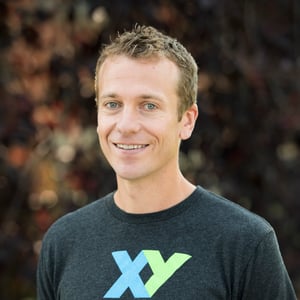How to Think Strategically About Your Business — Inspiration from XYPN PAUSE
Share this
We recently wrapped up a three-day business strategy retreat for business owners at the XYPN headquarters in Bozeman, Montana. This was part of a larger business strategy program called XYPN PAUSE.
At XYPN, we have been working to identify advisors by business phase (pre-registration, pre-launch, launch, and growth) to ensure we are providing the resources they need as their businesses grow and change over time. While the launch and growth phases share many similarities from firm to firm, we recognize and appreciate that business ownership and the type of business an advisor wants to build is unique to each advisor.
Once an advisor has grown and reached capacity as an individual advisor, they are faced with potentially monumental decisions that could have a lasting impact on their business.
Is it time to outsource certain activities, or hire staff? Should I stop taking in new clients, or should I continue to grow and add new advisors to help manage this growth?
We developed PAUSE with these questions in mind and to provide financial advisors the rare opportunity to quite literally pause and work on their businesses.
The primary goal of the program was for the advisors to take a step back and look strategically at their businesses, identify some of the key strategic decisions they're facing as business owners, and understand the implications, both positive and negative, of those decisions.
We partnered with Human Scale Business to design this program specifically for XYPN advisors who have grown to capacity and are facing some key decisions in their businesses.
My hope in sharing some insights from PAUSE is that you will feel inspired to look at your own business strategically and feel empowered to confidently make some of the difficult decisions you've been grappling with.
Setting the Stage
We started by setting the stage with some of the elements of adaptive strategy. This was done through a series of videos and online resources to help introduce a way of thinking and common vocabulary for the participants. One of these concepts included decision-making with the OODA cycle.
The OODA cycle is an acronym for observe, orient, decide, and act. This process and way of thinking became a central theme of the program and provided a framework for program participants to think about different challenges they are facing.
After introducing elements of adaptive strategy, we set the foundation for the participants with some business fundamentals, including an empathy map canvas, value proposition canvas, and business model canvas.
The business model canvas captures nine building blocks essential to any business:
- One or more well-defined Customer Segments
- Corresponding Value Propositions that match bundles of products and services to important customer jobs, essential gains, and extreme pains
- The Channels through which value propositions are communicated and delivered to targeted customer segments
- Customer Relationships established and maintained with customer segments
- The Revenue Streams resulting from the successful delivery of value propositions to customers
- Key Resources—tangible and intangible assets and accumulations—necessary to offer and deliver the preceding
- The Key Activities related to the cultivation, use, and sustainment of key resources over time
- Key Partnerships that represent access to certain key resources and the capacity to engage in key activities
- The Cost Structure resulting from the resources, activities, and partnerships that make the delivery of your value proposition possible
Source: Human Scale Business
The purpose of these canvases was to get advisors thinking about how their businesses create, deliver, and capture value for their clients.
Prior to starting any of the group calls or in-person meetings, each participant completed these canvases and shared them with the group. This was the first of many times throughout the program that the participants would complete the business model canvas; by going through this exercise multiple times, participants started to see how each of the individual components of their businesses are interconnected.
With the strategy basics set and the business fundamentals laid out, the next portion of the PAUSE program was to bring the participants together in group calls. We completed two rounds of calls before the in-person portion of the meeting.
The purpose of the first call was to introduce the participants to one other, share challenges, and start to identify key resources and activities in their businesses. The format of the calls allowed the participants to break out into small groups and discuss and then come back to the group and share the group feedback.
This first session helped the advisors start to vocalize the big picture challenges facing their businesses, such as:
“Do I want to stay solo or start to build a multi-advisor practice?”
“How do I continue to grow, but also provide the level of service to my clients?”
“How do I build a business that doesn’t rely on me?”
After sharing these challenges, the participants discussed some of the key resources and activities that are essential to their businesses.
While the first round of calls focused on each advisor looking at the big picture, the next round of calls focused on some immediate solutions to the advisors' biggest challenges.
During the second round of calls, the participants used the Troika Consulting method to continue discussing their challenges and to start identifying some immediate solutions.
The Troika Consulting method follows a process of one client and two consultants. The client describes the issue they would like the consultants’ input on, the consultants ask clarifying questions, and then the consultants discuss advice and ideas for the client. The client listens to their advice and ideas and then shares what was most valuable.
This exercise was followed by identifying “15% solutions” for the challenge that the advisor was facing. The idea behind 15% solutions triggering big change by starting small, a sentiment perfectly captured by the quote, “Even a 100-mile journey starts with a single step.”
Following this framework, advisors asked themselves what they could do today with their existing resources to start making progress with the realization that a few small steps can lead to momentum and big results in their businesses.
In-Person Retreat
With the foundation set and the first two rounds of calls completed, it was time to host the advisors at the new XYPN office in Bozeman, Montana. Prior to arriving in Bozeman, we asked the participants to self-identify what type of business they ultimately wanted to build: a multi-advisor business or a solo-advisor business.
Three advisors identified as a “solo advisor”, eight as a ”multi advisor”, and the rest as undecided.
Typically, when we label these two types of financial advisory businesses, the decision point for the advisor is whether they want to run the business or continue to be the lead planner.
Most that opt for the multi-advisor business gravitate towards running the business because they don’t have the time to work with clients and take care of the many other aspects of the business.
Those who want to continue to be the lead planner will generally gravitate towards the solo-advisor business and will start to find ways to refine who their ideal client is and, at some point, will stop taking on new clients.
As we discussed this concept of building a multi- versus solo-advisor business, it quickly became apparent there was actually a third option. Many participants weren’t interested in adding multiple advisors at that particular time and were wary of scaling quickly; instead, they had aspirations of growing their businesses beyond them and doing so in a smart way that won’t upend their business.
These discussions set the stage for the first day of business strategy sessions. Each advisor had previously completed their own business model canvas for their business; now they broke into their respective groups—multi-advisor, solo-advisor, and undecided—and completed the business model canvas together. The real value in this exercise was felt when all three groups came back together and started discussing their common elements and the similarities and differences between the multi-advisor and solo-advisor businesses.
Throughout the first business strategy session, the Human Scale Business facilitators introduced concepts such as thinking dynamically and charting behavior over time rather than looking at a static picture, the two sides of the business brain, and the rookie versus pro pipeline.
All of these concepts helped illustrate how each of the different aspects of a business are interconnected and how a simple decision on hiring can affect revenue, staff satisfaction, and client retention.
This led into a discussion about how creating models helps show how certain intakes can have strategic and practical implications on a business. At this point, the advisors started to identify different types of modeling they would like to see for their specific businesses. Going through the exercise of modeling and starting to view what happens to certain resources as activities increase or decrease helped tie the entire program together for the advisors.
It is easy to get focused on the specific models and tweaking factors such as the number of clients, impacts revenue, staff pressure, and expenses. The value in modeling is that it allows business owners to test certain hypotheses and foresee potential impacts prior to implementing changes. As a business owner, this allows you to understand the implications of your decisions on your entire business and make decisions that will create long-term growth and sustainability for your business.
As the participants wrapped up the in person portion of the PAUSE program, we discussed next steps. Each advisor set actionable goals to implement in their businesses and discussed what they needed from XYPN, each other, and their networks to accomplish their goals. During the next phase of the program, PAUSE participants will dive deeper into modeling and follow-up on action items through group calls.
Financial advisors focus so much of their time on helping their clients achieve their most important financial and life goals that many don’t take the time to properly plan their own businesses. This leads to reactionary decisions made out of necessity instead of well-thought-out and tested decisions that support a greater vision.
The purpose for creating PAUSE was to prevent this by providing advisors resources for evaluating their current businesses, techniques for strategic planning, and an opportunity to start planning strategically.
While the PAUSE program is designed to help advisors think strategically about the key decisions facing their businesses, we have found the real value of participating in this type of program is the networking and discussions that happen between the participants.
Facilitating ways for successful business owners to discuss their businesses, identify and find solutions to their challenges, and share their successes is one of the most important roles XYPN can play in helping advisors successfully navigate the often tumultuous journey of business ownership.

About the Author
As XYPN's Director of Advisor Success, Malcolm is tasked with doing just that—helping advisors succeed. After graduating from Gettysburg College with a B.A in Management, Malcolm jumped straight into the financial services industry and never looked back. With a drive to help shape the future of financial planning and a passion for bringing financial advice to the next generation of clients, he has a lot in common with the advisors in the Network.
Share this
- Advisor Posts (433)
- Fee-only advisor (388)
- Advice (316)
- Business Development (245)
- Independent Financial Advisor (204)
- Growing Your Firm (160)
- Marketing (132)
- Financial Planning (104)
- What Would Arlene Say (WWAS) (81)
- Firm Ownership (78)
- Business Coach (77)
- Training (76)
- Compliance (71)
- Business (69)
- Building Your Firm (68)
- Financial Advisors (65)
- Online Marketing (61)
- Events (60)
- Starting a Firm (50)
- From XYPN Members (48)
- Technology (48)
- Launching a firm (45)
- Advisors (42)
- Entrepreneurship (39)
- Taxes (39)
- Staffing & HR (38)
- Networking & Community (33)
- Interviews and Case Studies (32)
- Investment Management (32)
- XYPN Invest (28)
- Tax Preparation (27)
- Business Owner (25)
- Social Responsibility (25)
- Sales (24)
- Small Business Owner (20)
- Industry Trends & Insights (19)
- From XYPN Invest (18)
- Financial Planners (17)
- Independent Financial Planner (17)
- XYPN (17)
- Leadership & Vision (16)
- XYPN News (16)
- Tech Stack (15)
- How to be a Financial Advisor (14)
- RIA (14)
- Investing (13)
- Media (13)
- NextGen (13)
- Press Mentions (13)
- Financial Education (12)
- Goals (12)
- RIA Owner (12)
- XYPN Membership (12)
- Assets Under Management (AUM) (11)
- First Year (11)
- Niche (11)
- SEC (10)
- Advisor Success (9)
- RIA Registration (9)
- Communication (8)
- Lessons (8)
- Study Group (8)
- Time Management (8)
- Virtual Advisor (8)
- Growth (7)
- Mental Health (7)
- Pricing Models (7)
- From Our Advisors (6)
- Independent RIA (6)
- Money Management (6)
- Motivation (6)
- Preparing to Launch (6)
- Processes (6)
- Risk and Investing (6)
- Automation (5)
- Behavioral Finance (5)
- Broker-Dealers (5)
- College Planning (5)
- Filing Status (5)
- How I Did It series (5)
- Investment Planner (5)
- Michael Kitces (5)
- Preparing to Launch (5)
- Retirement (5)
- S Corpration (5)
- Scaling (5)
- Support System (5)
- TAMP (5)
- Wealth (5)
- Year-End (5)
- Bear Market (4)
- CFP Certification (4)
- Outsourcing (4)
- Selling a Firm (4)
- Small Business (4)
- State Registration (4)
- Succession Plans (4)
- Benchmarking Study (3)
- Bookkeeping (3)
- Budgeting (3)
- ESG Investing (3)
- Emotional Decisions (3)
- Engagement (3)
- Fiduciary (3)
- Financial Life Planning (3)
- Getting Leads (3)
- IRA (3)
- Life planning (3)
- Lifestyle practice (3)
- Membership (3)
- Millennials (3)
- Monthly Retainer Model (3)
- Monthly Subscription Model (3)
- Partnership (3)
- Pricing (3)
- RIA Audit (3)
- Recordkeeping (3)
- Risk Assessment (3)
- Staying Relevant (3)
- Wellness (3)
- Work Life Balance (3)
- Advice-Only Planning (2)
- Building Your Firm (2)
- Career Changers (2)
- Charitable Donations (2)
- Community Property (2)
- Design (2)
- Differentiation (2)
- Exchange-Traded Funds (ETF) (2)
- FINRA (2)
- Finding Your Why (2)
- Graphic design (2)
- Growing Income (2)
- Health Care (2)
- Inflation (2)
- Key performance indicator (KPI) (2)
- Keynote (2)
- Negative Rates (2)
- Operations (2)
- Organization (2)
- Outsourced Asset Management (2)
- Outsourced Bookkeeping (2)
- Portfolio Management (2)
- Productivity (2)
- Psychology (2)
- Quickbooks (2)
- Recommended Reading (2)
- Recruiting (2)
- Registered Representative (2)
- Registration (2)
- Restricted Stock Units (RSU) (2)
- Start Ups (2)
- Stock Options (2)
- Team Communication (2)
- Virtual Assistant (2)
- Virtual Paraplanner (2)
- Accounting (1)
- Arlene Moss (1)
- Assistant (1)
- Bonds (1)
- Bull Market (1)
- Careers (1)
- Certified Public Accountant (CPA) (1)
- Childcare (1)
- Client Acquisition (1)
- Client Services (1)
- Common Financial Mistakes (1)
- Consulting (1)
- Consumerism (1)
- Credit (1)
- Custodians (1)
- Custody Rule (1)
- Data (1)
- Daycare (1)
- Definitions (1)
- Designations (1)
- Direct Indexing (1)
- Disasters (1)
- Earn More (1)
- Family (1)
- Fidelity (1)
- Finance (1)
- Financial Freedom (1)
- Financial Goals (1)
- Financial Life Management (1)
- Financial Success (1)
- Financial Wellness (1)
- Form 8606 (1)
- Form 8915-E (1)
- Grief (1)
- Guide (1)
- How to Budget (1)
- Impostor Syndrome (1)
- Interns (1)
- Investor Policy Statement (IPS) (1)
- Job burnout (1)
- Liquidating your business (1)
- Loans (1)
- Moving Forward (1)
- Part Time (1)
- Paying Yourself (1)
- Paystub (1)
- Perfectionism (1)
- Project Management (1)
- Projecting Returns (1)
- Purpose (1)
- Quarterly Estimated Payments (1)
- RIA Operations (1)
- Recession (1)
- Referrals (1)
- Regulations (1)
- Regulators (1)
- Reinvention (1)
- Relationships (1)
- Remote (1)
- Required Minimum Distributions (RMD) (1)
- Risk Management (1)
- Roth Conversations (1)
- Roth IRA (1)
- Sabbatical (1)
- Spending (1)
- Strategy (1)
- Systems (1)
- Target Audience (1)
- Teamwork (1)
- Terms (1)
- To-Do List (1)
- Traditional IRA (1)
- Transitions (1)
- Virtual (1)
- Vulnerability (1)
- XYPN Books (1)
Subscribe by email
You May Also Like
These Related Stories

How to Activate and Accelerate Your Financial Planning Firm's Growth

The Benefits, Challenges, and Costs of Growing Your Firm



